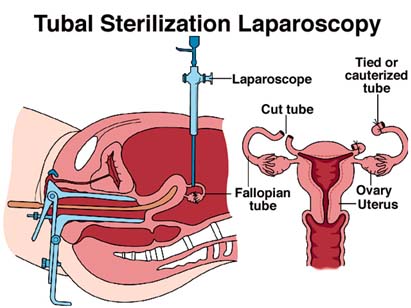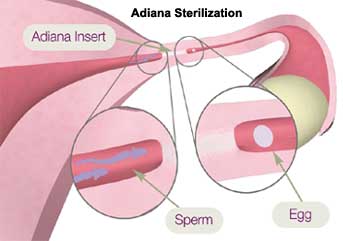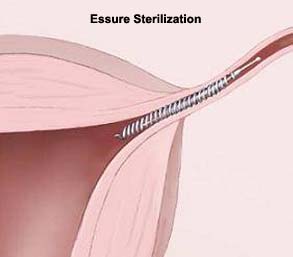Female Sterilization
Female sterilization is the permanent method of birth control for women. There are two types and these are Tubal Ligation and hysteroscopic sterilization. Tubal Ligation is surgical procedure that involves cutting or tying the fallopian tube to prevent released egg travel from ovary to the uterus which also prevents sperm from reaching the egg and pregnancy cannot happen without egg fertilization. The two most common methods of Tubal Ligation used are called laparoscopy and mini-laparotomy. Tubal Ligation was first use in 1930.
Hysteroscopic sterilization is non-surgical method that involves blocking the fallopian tube to prevent released egg from travelling to the uterus which also blocks sperm from reaching the egg and pregnancy cannot happen without egg fertilization. The two methods of hysteroscopic sterilization used are called Adiana and Essure. Adiana was approved for use in the United States by FDA in 2009. Essure was approved for use in the United States in 2002.

How it Works
In the laparoscopy procedure you are given general anesthesia. Your abdomen is inflated with carbon dioxide gas so the surgeon can have clear view of your organs. The surgeon make a small incisions near your navel and insert the laparoscope which is a tiny instrument with camera on the end, as the instrument is inserted through tiny abdominal incisions the surgeon can view the internal organs to locate the fallopian tubes.
The surgeon makes a second incision above the pubic bone and insert instrument for cutting and closing the tubes. The whole procedure may take about 30 minutes to complete. Laparoscopy is outpatient surgical procedure which means you can go home the same day. Laparoscopy is effective immediately after the surgery is completed unless you are already pregnant or the egg is already in the tube or in the uterus.
In the mini-laparotomy procedure you are given general anesthesia. In this procedure carbon dioxide gas and laparoscope are not used but instead the surgeon makes a small incision above the pubic bone to locate the fallopian tubes, the tubes are cut and closed off. This method of female sterilization is usually performed after childbirth. Mini-laparotomy is outpatient procedure and you can go home the same day. Mini-laparotomy is effective immediately after the surgery is completed.

The Adiana sterilization procedure involves the use of instrument called the hysteroscope which is inserted into the fallopian tubes through the vaginal opening. A small amount of heat is applied to each fallopian tube to removed thin layer of cell on the inside of each fallopian tube. Adiana is a soft flexible implant about the size of a grain of rice is inserted into both tubal opening. Natural tissue grows around the implant to create blockage between sperm and egg.
Adiana is not effective right after insertion, you need to wait 3 months for natural tissue to grow around the implant and you need follow up visit to get an x-ray to confirm each tube is fully blocked. In the mean time you should be using different method of birth control. Adiana is outpatient procedure that does not require surgery and the use of anesthesia.

The Essure sterilization procedure involves the use of instrument called the hysteroscope which is inserted into the fallopian tubes through the vaginal opening. Essure is a stainless steel implant with coil shape made of polyethylene fibers is inserted into both tubal opening. Natural tissue grows around the implant to create blockage between sperm and egg.
Essure is not effective right after insertion, you need to wait 3 months for natural tissue to grow around the implant and you need follow up visit to get an x-ray to confirm each tube is fully blocked. In the mean time you should be using different method of birth control. Essure is outpatient procedure that does not require surgery and the use of anesthesia.
Advantages
Female sterilization with Tubal Ligation (laparoscopy or mini-laparotomy) is a safe and permanent method of birth control. Tubal Ligation is effective immediately after surgery and you can engage in spontaneous sexual activity without the fear of pregnancy or worry about different method of birth control.
Your hormone level will not be affected after female sterilization, your body will continue to have normal periods and produce egg but the egg will simply degenerates. Sterilization will not affect the timing of your menopause such as causing menopause to happen earlier than usual. Sterilization will not affect your sex drive because your hormone levels are not affected and you will continue to enjoy your normal sex drive.
Hysteroscopic sterilization (Adiana or Essure) is also a safe and permanent method of birth control. Hysteroscopic sterilization is non-surgical method that does not require surgery and the use of anesthesia. You can recover very quickly once the procedure is implemented.
You can engage in spontaneous sexual activity without the fear of pregnancy or worry about different method of birth control. Your hormone level and menstrual cycle will not be affected and your body will continue to produce egg but the egg will simply degenerate. You can continue to enjoy your normal sex drive as your hormone levels are not affected.
Disadvantages
Female
sterilization with Tubal Ligation does not provide protection against
sexually transmitted diseases. During recovery you may experience pain
at the incision site or you may experience gas pain that can be very
painful. Tubal Ligation is the permanent method of birth control that
requires surgery and surgical reversal may not be possible if you decide
to have biological children in future. The surgical procedure for
female sterilization is much more complicated than
male sterilization.
Hysteroscopic sterilization does not provide protection against sexually
transmitted diseases. Hysteroscopic sterilization is not effective
right after insertion and you need to wait 3 months before you have
follow up visit to get x-ray that confirm each tube is fully blocked.
The tubes may not be fully blocked after 3 months and you may need to
wait additional 3 months if the tube is not fully blocked.
The implants
may not be inserted correctly in the first procedure and second
procedure may be required to make this correction. Hysteroscopic
sterilization is the permanent method of birth control and surgical
reversal may not be effective if you decide to have biological children
in future.
Return from Female Sterilization to Contraception
Return to Homepage Self Help Sexuality
Most Popular
Erotica Sex Stories That Will Make Your Cock Dripping Wet
Erotic Stories That Will Make Your Cock Very Wet & Sticky
Cum Stories That Will Make You Rock Hard & Horny
Masturbation Stories That Will Make You Throbbing Really Hard
Sex Stories That Will Make You Really Hard & Horny
Hot Sex Story That Will Make You Really Stiff & Hard
Group Sex Stories That Will Make You Very Hard & Wet
Recent Sex Stories Updated For Your Pleasure